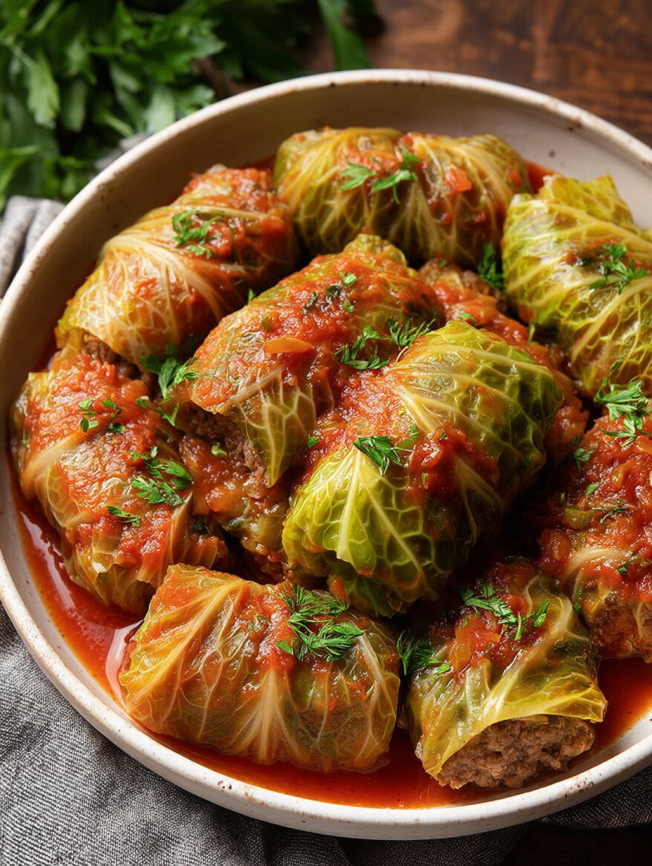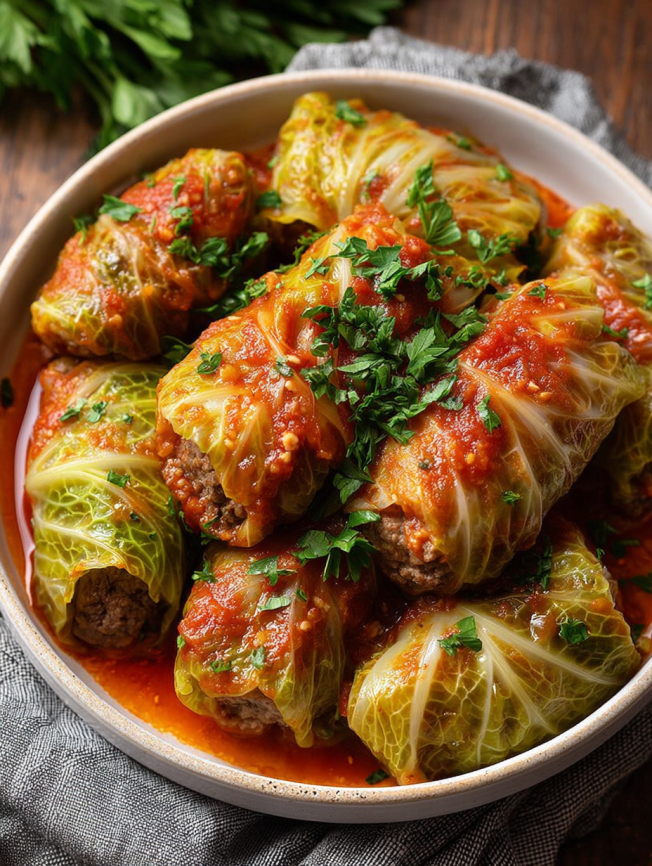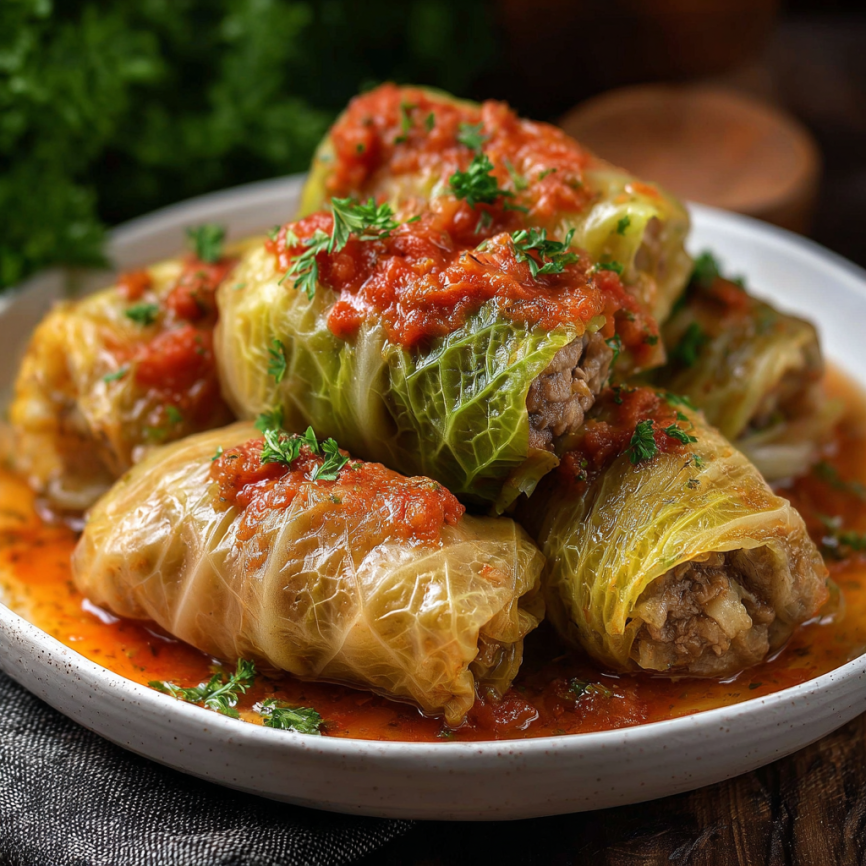Sunday afternoons at my Turkish grandmother’s house were always filled with the gentle bubbling of her large copper pot, steam carrying the most incredible aromas throughout her small kitchen. There she would stand, patiently rolling each cabbage leaf around spoonfuls of perfectly seasoned meat and rice, her weathered hands moving with the precision of decades of practice. These weren’t just stuffed cabbage rolls to her – they were edible memories, each one wrapped with stories of her homeland and love for her family.
Today, whenever I prepare Lahana Sarması, I’m transported back to those precious moments. This dish represents everything beautiful about traditional cooking: patience, technique, and the magical transformation of simple ingredients into something truly extraordinary. Moreover, it’s a recipe that brings people together, creating an excuse for families to gather in the kitchen and share in the meditative process of rolling and sharing stories.
Why This Recipe Will Become Your New Comfort Food Obsession
A Perfect Balance of Nutrition and Satisfaction
Stuffed cabbage rolls offer the ideal combination of lean protein, complex carbohydrates, and vegetables all wrapped in one delicious package. The cabbage leaves provide fiber and essential vitamins, while the meat and rice filling delivers sustained energy and satisfying richness. Additionally, the slow-cooking process allows all flavors to meld together, creating a depth that’s impossible to achieve with quick-cooking methods.
Incredibly Budget-Friendly Family Meal
This recipe transforms inexpensive ingredients into a feast that easily feeds six people. Ground beef, rice, and cabbage are all economical staples that most families can afford regularly. Furthermore, the dish actually tastes better the next day, making it perfect for meal planning and leftover lunches.
Cultural Authenticity Meets Home Kitchen Practicality
While deeply rooted in Turkish tradition, this recipe adapts beautifully to modern kitchens without requiring specialized equipment or hard-to-find ingredients. The techniques are straightforward enough for beginners, yet the results are sophisticated enough to impress dinner guests.
Essential Ingredients and Their Cultural Significance
The Foundation Elements
- 1 large head of cabbage (choose firm, heavy heads with tightly packed leaves)
- 1 pound ground beef (provides rich, savory flavor and substantial protein)
- 1/2 cup uncooked rice (adds texture and helps bind the filling)
The Flavor Builders
- 1 onion, finely chopped (essential for sweetness and depth)
- 2 cloves garlic, minced (brings pungent warmth to the mixture)
- 1/4 cup chopped fresh parsley (adds brightness and color)
- 1/4 cup tomato paste (concentrates tomato flavor throughout the filling)
The Spice Symphony
- 1 teaspoon paprika (provides mild heat and beautiful color)
- 1 teaspoon salt (enhances all other flavors)
- 1/2 teaspoon black pepper (adds subtle warmth and complexity)
- 3 tablespoons olive oil (contributes richness and helps with cooking)
The Sauce Components
- 2 cups tomato sauce (creates the cooking liquid and serving sauce)
- 1 cup hot water (helps create steam for gentle cooking)
Mastering the Art of Cabbage Preparation
Selecting and Preparing the Perfect Cabbage
Begin by choosing a large, firm cabbage head with bright green outer leaves. Carefully remove the core using a sharp paring knife, creating a cavity that allows you to separate the leaves more easily. This technique prevents tearing and ensures you get the maximum number of usable leaves.
The Blanching Process
Bring a large pot of salted water to a rolling boil. Carefully separate the cabbage leaves, starting from the outside and working inward. Blanch the leaves in batches for 2-3 minutes until they become pliable but not overly soft. The goal is to soften them just enough for rolling without making them mushy.
Immediately transfer the blanched leaves to a bowl of ice water to stop the cooking process. This technique, known as shocking, preserves the leaves’ vibrant color and prevents overcooking. Pat each leaf dry with paper towels before using
Creating the Perfect Filling
Building the Flavor Base
In a large mixing bowl, combine the ground beef with the uncooked rice. The rice will cook during the long simmering process, absorbing the meat juices and expanding to create the perfect texture. Add the finely chopped onion and minced garlic, ensuring they’re distributed evenly throughout the mixture.
Incorporating the Aromatics
Fold in the fresh parsley, tomato paste, paprika, salt, and pepper. Mix everything thoroughly with your hands – this ensures the most even distribution of flavors. The mixture should be well-combined but not overworked, which could make the final texture tough.
Testing for Seasoning
Before rolling all your cabbage leaves, cook a small portion of the filling in a skillet to taste for seasoning. This allows you to adjust salt, pepper, or spices before committing to the entire batch.

The Art of Rolling and Assembly
Proper Rolling Technique
Place each cabbage leaf on a clean work surface with the stem end facing you. Trim any thick stem portions that might prevent even rolling. Place a heaping tablespoon of filling near the stem end of each leaf, leaving space around the edges.
Fold the bottom edge over the filling, then fold in the sides to create neat edges. Roll tightly but gently toward the top of the leaf, creating a compact cylinder. The key is maintaining consistent pressure without tearing the delicate leaves.
Strategic Pot Arrangement
Layer the completed rolls seam-side down in your cooking pot, packing them snugly but not crushing them. This arrangement prevents them from unrolling during the long cooking process. If necessary, create a second layer, arranging the rolls perpendicular to the first layer for stability.
The Slow-Cooking Magic
Creating the Perfect Cooking Environment
Combine the tomato sauce, hot water, and olive oil in a separate bowl, whisking until well blended. Pour this mixture gently over the arranged cabbage rolls, ensuring the liquid reaches about halfway up the rolls. The sauce will reduce and concentrate during cooking, creating a rich, flavorful base.
Temperature and Timing Mastery
Cover the pot tightly and bring the liquid to a gentle simmer over medium heat. Once simmering, reduce the heat to low and cook for 1.5 hours. The low, slow cooking method ensures the cabbage becomes melt-in-your-mouth tender while the rice cooks perfectly and the flavors meld together harmoniously.
Check occasionally during cooking, adding more hot water if the liquid level drops too low. The rolls should remain partially submerged throughout the cooking process.
Serving Suggestions and Traditional Accompaniments
Classic Turkish Presentation
Traditionally, stuffed cabbage rolls are served with a dollop of thick, tangy yogurt that provides a cooling contrast to the rich, savory rolls. The yogurt’s acidity cuts through the richness while complementing the tomato-based sauce beautifully.
Modern Serving Ideas
For a complete meal, serve the rolls alongside crusty artisan bread for soaking up the delicious sauce. A simple cucumber and tomato salad dressed with olive oil and lemon juice provides fresh contrast to the hearty rolls. Additionally, rice pilaf makes an excellent accompaniment for those who want extra starch.
Elegant Dinner Party Style
Present individual portions in shallow bowls, spooning extra sauce around each roll. Garnish with fresh parsley and a drizzle of good olive oil for an elegant presentation that showcases the dish’s rustic beauty.
Creative Recipe Variations
Protein Alternatives
While ground beef is traditional, this recipe works beautifully with ground lamb, turkey, or a mixture of beef and pork. Lamb adds a rich, slightly gamy flavor that pairs exceptionally well with the tomato sauce. For lighter versions, ground turkey creates equally delicious results with fewer calories.
Vegetarian Adaptations
Create satisfying vegetarian versions by replacing the meat with a mixture of cooked lentils, chopped mushrooms, and extra rice. Add toasted pine nuts and raisins for texture and sweetness. This variation is popular in Turkish cuisine and offers the same comforting satisfaction as the meat version.
Regional Spice Variations
Experiment with different spice blends to create unique flavor profiles. A pinch of cinnamon and allspice adds warmth and complexity, while fresh dill instead of parsley creates a brighter, more herbaceous note. Some regions add a touch of bulgur wheat along with the rice for additional texture.
Make-Ahead Strategies and Storage
Assembly Advantages
These rolls can be completely assembled up to two days in advance and stored covered in the refrigerator before cooking. This make-ahead approach actually improves the flavor as the seasonings have more time to penetrate the meat and rice mixture.
Batch Cooking Benefits
The recipe doubles or triples easily, making it perfect for feeding large families or preparing freezer meals. Cook extra batches and freeze them in portion-sized containers for quick weeknight dinners. Frozen cooked rolls keep well for up to three months.
Reheating for Best Results
Leftover rolls reheat beautifully in a covered pot with a splash of additional tomato sauce or water. Heat gently over low heat for 15-20 minutes until warmed through. This method maintains the rolls’ texture and prevents them from drying out.
Essential Tips for Perfect Results
Leaf Selection Strategy
Use the larger outer leaves for rolling, saving smaller inner leaves for other uses like soup or sauerkraut. The ideal leaves are about palm-sized and free from tears or holes. If you have leftover small leaves, chop them and add to the cooking liquid for extra flavor.
Preventing Common Mistakes
Avoid overstuffing the leaves, which can cause them to burst during cooking. Additionally, don’t skip the blanching step – raw cabbage leaves are too rigid for proper rolling and won’t achieve the desired tender texture.
Quality Control Measures
Test one roll before cooking the entire batch by simmering it separately for 30 minutes. This allows you to adjust seasoning or cooking liquid as needed before committing to the full recipe.
Nutritional Benefits and Health Considerations
Complete Nutrition Profile
Each serving provides approximately 290 calories with a excellent balance of protein, carbohydrates, and healthy fats. The cabbage contributes vitamin C, fiber, and antioxidants, while the lean beef provides iron and B-vitamins essential for energy metabolism.
Digestive Health Benefits
Cabbage contains natural probiotics and fiber that support digestive health. The slow-cooking process breaks down tough fibers, making the nutrients more bioavailable while maintaining the vegetable’s beneficial compounds.

Frequently Asked Questions
Q: Can I use savoy cabbage instead of regular green cabbage? A: Absolutely! Savoy cabbage actually works wonderfully for this recipe because its leaves are naturally more tender and pliable. The ruffled texture also holds the filling well. Just reduce the blanching time slightly since savoy cabbage softens more quickly than regular cabbage.
Q: What should I do if my cabbage leaves tear during preparation? A: Small tears aren’t a problem – simply overlap the torn edges when rolling, or use torn leaves as patches. For larger tears, reserve those leaves for chopping and adding to the cooking liquid for extra flavor. Always have a few extra leaves prepared as backups.
Q: How can I tell when the rolls are fully cooked? A: The cabbage should be fork-tender and easily pierced, while the filling should feel firm when gently pressed. The rice should be completely cooked and no longer crunchy. If you’re unsure, carefully unwrap one roll to check that the rice is tender and the meat is cooked through.
Q: Can I make these rolls in a slow cooker? A: Yes! Layer the rolls in your slow cooker, add the sauce mixture, and cook on low for 6-8 hours or high for 3-4 hours. The slow cooker method produces incredibly tender results, though you might want to reduce the liquid slightly since there’s less evaporation.
Q: What’s the best way to freeze cooked cabbage rolls? A: Cool the rolls completely, then place them with their sauce in freezer-safe containers or heavy-duty freezer bags. They’ll keep for up to 3 months. Thaw overnight in the refrigerator and reheat gently in a covered pot with a splash of additional liquid if needed.
Prep Time: 30 minutes | Cooking Time: 1 hour 30 minutes | Total Time: 2 hours
Calories: 290 kcal per serving | Servings: 6

